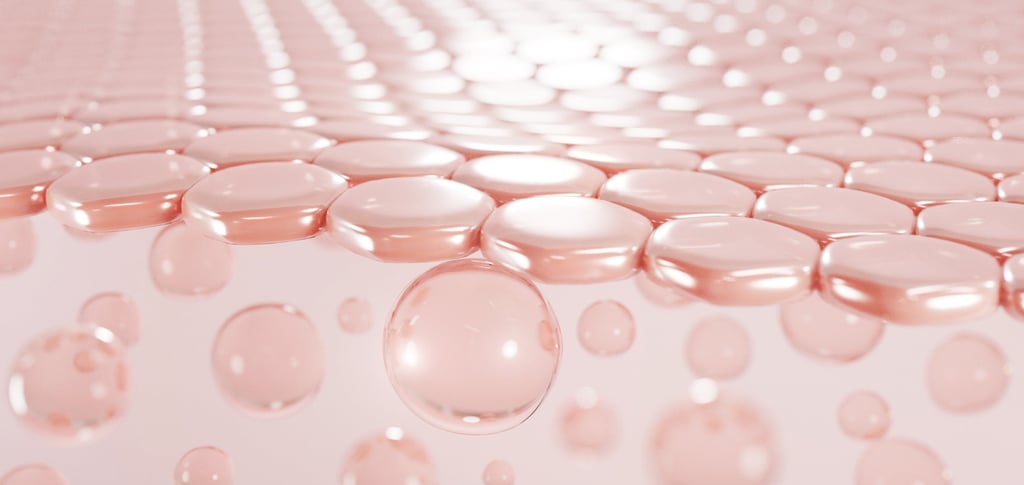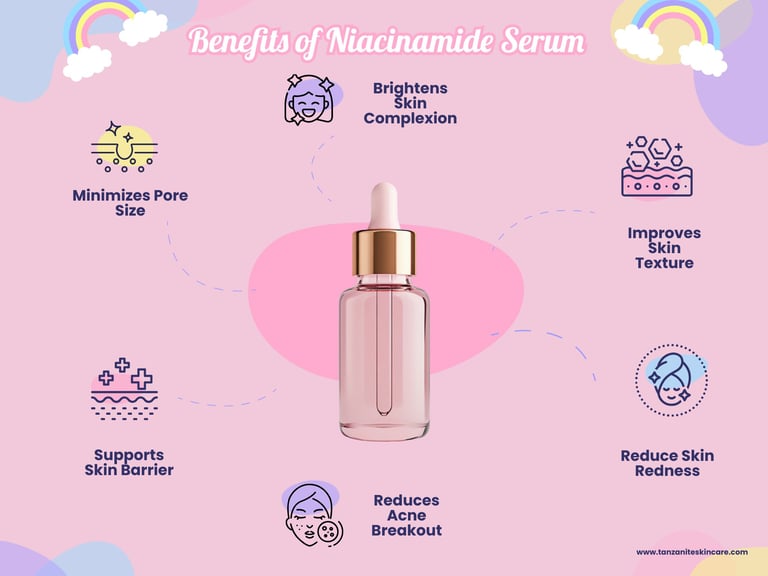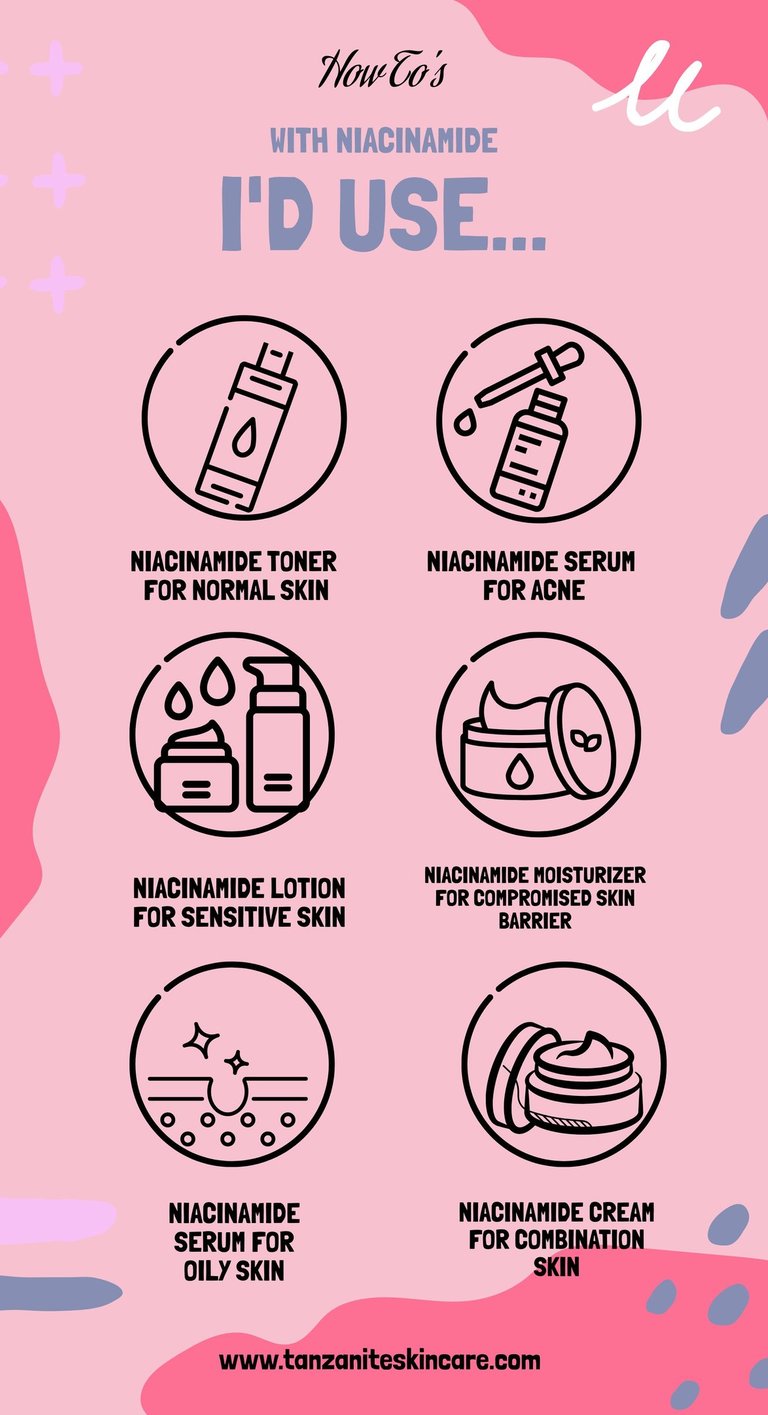Serum With Niacinamide, Benefits for Skin: What's the Buzz About?
SKINCARE INGREDIENTS


Overview
What is Niacinamide?
Niacinamide, another popular skincare ingredient in the market! Niacinamide also known as nicotinamide or Vitamin B3, is a water-soluble vitamin that is needed by the body for energy production.
Niacinamide (Vitamin B3) is found in most food sources whether its animal-based or plant-based and processed foods or grains can be fortified with vitamin B3. Some examples are
Brown rice
Green peas
Peanuts
Fish
Beef
Fortified Cereals
Niacin or niacinamide dietary supplements
Niacinamide vs Niacin
Now, before we continue with getting to know about niacinamide, it’ll be wise to address the difference between niacinamide and niacin.
Niacin is known as nicotinic acid is made by plants and animals from amino acid tryptophan usually used for heart health while Niacinamide/nicotinamide has high bioavailability than niacin since it is closely related to NAD and can promote cellular activity and even longevity.
On the other hand, niacinamide is well-tolerated while niacin could cause skin flushing when consumed in high amounts.
Both niacin and niacinamide are water-soluble in both forms but niacinamide is considered more better when it comes skincare.
Are niacinamide and nicotinamide same?
Yes, this difference in spelling and pronunciation should not confuse you. Niacinamide is a US-based adopted name while nicotinamide is UK or British approved name.
FUN FACTS
There are traces of both nicotinic acid or nicotinamide that have been found in extra-terrestrial objects such as meteorites.
Deficiency of vitamin B3 can cause a disease known as pellagra though it is rare in developed countries.
Vitamin B3 was discovered between 1935 to 1937 by American biochemist, Conrad Arnold Elvehjem.
Tanzanite Skincare
Table of Contents
1.0 Overview
1.1 What is Niacinamide?
1.2 Fun Facts
2.0 Niacinamide, What Does It Do?
4.0 Are There Any Risks Involved When Using Niacinamide?
5.0 Vitamin B3 Foods and Supplements
6.0 What is Compatible with Niacinamide?
7.0 What Cannot be Mixed With Niacinamide?
9.0 How to Use Niacinamide In Skincare Routine
10.0 Final Takeaway
11.0 Frequently Asked Questions
12.0 References
Niacinamide, What does it do?
You first have to know that niacinamide when applied topically affects many pathways that can be seen as healthy skin.
Niacinamide works by inhibiting nuclear poly (ADP-ribose) polyremase-1 (PARP-1) enzyme which in turn it can help the skin to reduce inflammation and provide photo-protection. Niacinamide can also support ceramide production in the skin layers.
Niacinamide for Skin
Niacinamide is very popular and is for the right reasons, together let’s explore the world of skincare with niacinamide. This article is going to focus most of its aspects on how beneficial niacinamide is for skin.
1. Reduces Oxidative Stress
You have to know that niacinamide is a very potent anti-oxidant that can fight off free radicals. Niacinamide can help quench reactive oxygen species (ROS) due to their anti-aging properties.
There is a lot of evidence to support this claim due to many clinical trials pointing out that niacinamide of 4% to 5% in cosmetic formulations can provide anti-aging benefits to the skin than placebo group.
2. Improves Skin Elasticity
As we age the skin layer starts to lose moisture and essential lipids that can make your skin to crack and flaky. Niacinamide can improve skin and make it more elastic since it provides more firmness which is good for the skin to avoid wear and tear of the skin.
Some studies have shown that niacinamide can improve skin elasticity making the skin texture smooth on the way.
3. Reduces Acne Breakouts
Acne vulgaris is among the commonest skin concern which many people struggle with. There are many skincare products out there that promise clear skin. Niacinamide is the best out there since it has less side effects, it’s non-comedogenic, it’s anti-microbial can clear the skin since it discourage the acne-causing bacteria to live on the skin. It can also treat acne lesions.
Several studies found out that niacinamide was better at acne treatment than other standard care acne treatments
Is Niacinamide Good for Acne?
One skin expert Dr. Anne was quoted saying, “…Yes! Because of its anti-inflammatory action and because it reduces sebum production. Less sebum means less breeding ground for bacteria. The anti-inflammatory effect will also help reduce the side effects of other, more aggressive therapy options, like retinoids and benzoyl peroxide…”
4. Reduces Skin Yellowing
Skin yellowing also known as sallowness can affects some people. It may be caused by liver issues or some other diseases. Facial skin yellowing can be reduced by applying niacinamide.
A study done in a 12-week period showed improvements of skin yellowing together with other positive effects such as firmness, reduce pigmentation and skin discoloration.
5. Brightens the Skin
Niacinamide unlike retinol or vitamin C and other skincare ingredients is that it is well-tolerated and has less side effects such as skin redness, irritation, erythema or inflammation.
Niacinamide can brighten the skin, fade out acne scars and dark spots. With niacinamide concentration of 2% to 10%, you can lighten the skin as well as make the skin glowing and radiant.
Another study found out that niacinamide is effective in lightening hyperpigmented skin by reducing transfer of melanosomes to keratinocytes.
6. Reduce Sebum Production
For those with oily skin, niacinamide can be a live-saver. Long are gone those days where your face will glisten with oil as soon as you step out of the door. Niacinamide can really help to control oil production in skin sebaceous glands that maybe hyperactive or inflamed.
One study found out that 2% niacinamide was effective in reducing sebum production in a matter of 2 to 4 weeks among Japanese subjects.
7. Increase Skin Hydration
Another thing that using niacinamide might help with is reduce transdermal water loss (TEWL) which in turn can improve skin hydration and moisture in the skin layers. But also niacinamide has small molecular size that ensure deeper skin penetration.
8. Improving Melasma
Niacinamide can lighten hyperpigmentation caused by hormonal fluctuation with less adverse effects such as skin redness, burning sensation, itchiness, irritation which accompanies most of the skincare ingredients like retinol, AHAs and vitamin C.
A research study found out 4% niacinamide improved facial melasma with no adverse effects in comparison to hydroquinone.
9. Presents Signs of Aging
When you use niacinamide over a long period of time, your skin will experience not only brightening but also reduction in fine lines and wrinkles. Niacinamide can also provide some form of photo-protection due to its anti-oxidant properties. Though this should not be confused and used as a reason to skip sunscreen.
10. Improves Skin Barrier Function
As we know skin barrier is better kept intact and healthy for youthful appearance, skincare ingredients such as niacinamide can really support skin to avoid compromising it. Niacinamide can repair the skin by promoting the production of lipids and proteins such as ceramides, fillagrin, keratin and involucrin can enhance the skin layer and avoid dangerous elements and microbes from entering the body.
A clinical study demonstrated that niacinamide provided conducive environment for formation of ceramides which is important in skin health.
11. Reduces Skin Inflammation
If you’re new in skincare game then you might want to try niacinamide before going to harsher ingredients like AHAs or retinol. If you have dry or sensitive skin then opting for niacinamide is better choice because of its anti-inflammatory properties.
Niacinamide can reduce inflamed skin experiencing redness, dryness, irritation or itchiness.
12. Potential to Reduce Risk of Skin Cancer
Some research studies have discovered that niacinamide may hold a great potential in helping to reduce chances of skin cancer or developing one. This is good news to the skincare community since to most individuals, niacinamide is well-tolerated and it can be added in different formulations in the skincare products from face cleansers to lotions to sunscreens, this ingredient can fit anywhere.


Are There Any Risks Involved When Using Niacinamide?
Overall, niacinamide is among well-tolerated and effective skincare ingredients in the market. There are less chances of you experiencing side effects such as erythema, burning sensation, irritation or rashes.
If you get any of the adverse effects it can be coming from the other ingredients rather than niacinamide itself. Do some patch test before using any niacinamide containing products before you decide to add them in your skincare routine.
Is it OK to use niacinamide everyday?
Niacinamide can be used everyday as part of any healthy, consistent skincare routine. You can use it in morning (AM) and/or evening (PM) routine. If you ‘re skeptical then you can always start with low concentration of 2% then you can increase it on the way as you go, to 5% to 10% niacinamide.
Vitamin B3 Foods and Supplements
Vitamin B3 also niacinamide can be found in plenty of foods both animal-based and plant-based, it is so abundant that its rare to suffer from lack of it. Here are some few examples
Plant-based: Potatoes, Green Peas, Mushrooms, Whole wheat and peanuts and other leafy greens.
Poultry: Chicken breast, Turkey
Seafood: Tuna, Salmon, Anchovies,
Porcine: Pork, bacon
Organ meats: Liver and kidneys
Which Vitamin B3 Supplements Are Best?
When it comes to skin health niacinamide is the best out there. First, you avoid the risk of getting flushing, a side effect observed when taking niacin. Niacinamide can be easily absorbed by the body and has high efficacy than niacin but also if you take higher doses of niacinamide they’re likely to be excreted out of the body.
It also a good idea to look for a mineral micronutrient such as zinc in your niacinamide supplements. Niacinamide supplements can be found in forms of powder, tablets, capsules, gummies even liquid form.
What is Compatible with Niacinamide?
Niacinamide, as said before is well-tolerated and can be mixed with other ingredients too. If you can strike good balance with combination of niacinamide and retinol, vitamin C, hyaluronic acid, AHAs and BHAs. In fact, niacinamide can counter the side effects of other ingredients. Now let’s take a look
Hyaluronic Acid and Niacinamide
Hyaluronic acid is vey hydrating and also can be tolerated. If you have dry and sensitive skin or acne-prone skin then this combination can be so powerful. Hyaluronic acid and niacinamide can reduce acne, while calming and soothing these kind of skin types and compromised skin barrier.
Can you use Niacinamide and Hyaluronic Acid Together?
Absolutely! Niacinamide and hyaluronic acid can be mixed in one skincare routine, start with niacinamide followed by hyaluronic acid if you’re using them both in one step since niacinamide has smaller molecular size than hyaluronic acid despite them being water-based ingredients.
Read More: Hyaluronic Acid for Skin: Benefits, Tips, Secrets and All-in-Between!
Vitamin C and Niacinamide
You can always use vitamin C and niacinamide together in a skincare routine. You can also choose to use niacinamide in the morning routine while you opt vitamin C for evening routine especially if you want to avoid photo sensitivity when using vitamin C.
You can also use them in steps of one skincare routine niacinamide can counter the effects by soothing the skin from redness or mild irritation from vitamin C which can stimulate collagen synthesis in the skin.
Read More: How to Use Vitamin C Serum in Your Skincare Routine for Beautiful Skin
Retinol and Niacinamide
When it comes to retinol, it is always difficultly to use retinol with other actives but niacinamide, fortunately can be used together in one skincare routine. In fact, niacinamide can reduce side effects such as dryness, irritation, redness or burning sensation which can come with using retinol.
Dr. Karam had this to say, “…if you’re somebody who uses retinol for example or uses glycolic acids etc and your skin gets irritated, well the presence of niacinamide in your skincare routine can calm the skin and help you tolerate those things even better…”
Which Comes First Niacinamide or Retinol?
Obviously!, its niacinamide because it is water-based ingredient. When applying in the steps start with niacinamide serum followed by oil-based ingredient, retinol. Though you have to notice on the formulation of the products themselves in mind.
Vitamin B5 (Panthenol) and Niacinamide (Vitamin B3)
These two can be used without causing any skin issues. Don’t hesitate to include both of hem in one session of skincare routine especially if you have dry skin. These ingredients can provide hydration at deeper levels of the skin.
Is Niacinamide the same as vitamin B5?
Not at all, sometimes people can confuse vitamin B3 (Niacinamide) and vitamin B5 (Panthenol) but these two active ingredients are different from one another with different roles to play in the skin. The only thing they share are both vitamin B’s and water-soluble in different forms. For more information go and get more insights in this post down below:
Read More: Vitamin B5 for Skin + How to Add It In Your Skincare Regimen
Azelaic Acid and Niacinamide
Niacinamide can be incorporated with azelaic acid in a skincare routine. Niacinamide can brighten the skin while azelaic acid has anti-inflammatory properties to soothe and calm the skin.


What Cannot be Mixed With Niacinamide?
As with any skincare active ingredient, not everything and anything can be paired with niacinamide in one skincare routine especially if used as leave on products. Combination with niacinamide may lead to skin redness, dryness, burning sensation or have skin disorders such as psoriasis, eczema and rosacea especially when used simultaneously in one skincare routine session. So knowing not to mix them will put you on the safe side. Some of this ingredients are
Niacinamide and Alpha Hydroxyl Acids(AHAs)
AHAs are know to be aggressive to the skin due to their exfoliating properties. If you’re using products containing glycolic acid, lactic acid, malic acid or mandelic acid then you should avoid using them with niacinamide to avoid exacerbating your already compromised skin after exfoliating it.
Niacinamide and Salicylic Acid
This is another exfoliating acid and you should probably avoid it too when using niacinamide. Mix BHAs like salicylic acid and niacinamide is not a good idea instead look for something gentle to work with in especially in serum step.
If you want to mix them look for concentration levels and steps in which you’re going to layer them on. Use salicylic acid in wash off products and niacinamide in leave on products if you really need to include them in one routine.
At Which Concentration should I Use Niacinamide?
As a beginner you can start with low concentration of 2% and then you can increase it to higher level of 5% to 10% niacinamide, looking if you can tolerate and if you get more desired positive results.
When Should I Expect Results After Using Niacinamide?
Niacinamide is not some kind of magical elixir or portion that will get rid of your skin problems in one go. It can take from 4 to 12 weeks to start seeing visible positive results.
How Do I Know Niacinamide Is Working?
You’ll start to notice some changes on skin texture, skin getting brighter then acne scars fading off as weeks roll by, by week 6 your skin should be better off than when you started using niacinamide.
Niacinamide and Skin Type
Oily Skin
For those with oily and/or acne-prone skin then including niacinamide in your skincare regimen could be life-changing thing to do. Niacinamide clear and minimize pores meanwhile fade out acne scars and reduce sebum production.
Dry Skin
If you prefer something gentle to your skin that is not drying then choose other than niacinamide serum. It can brighten your skin while penetrating deeper into skin layers ensuring hydration.
Sensitive Skin
Most of the time for those with sensitive skin type, active ingredients like retinol and vitamin C may not be something to go to even if are formulated at lower concentration. Instead, choose niacinamide serum for brighter skin tone without adverse side effects like redness or irritation.
Though, niacinamide serum will take quite sometime before you start to notice any significant changes to your skin luminosity and texture. It may take up to over 12 weeks, so patience is highly needed here.
Atopic Dermatitis
This is not a skin type but rather a skin disorder. Anyone with this skin condition may benefit more from using niacinamide since its gentle has both anti-aging and anti-inflammatory properties that can help to soothe and calm your skin.
Psoriasis
Another skin condition that can be calmed is psoriasis. There is even research to support use of niacinamide to reduce redness to skin facing these condition.
If you have no severe skin condition and fall in category of normal, combination or mature skin don’t feel left behind, you can always use niacinamide in your skincare routine though for you guys there are far better options which can bring faster results such as vitamin C or retinol/tretinoin.
How to Use Niacinamide In Your Skincare Routine
There are many ways you could use niacinamide topically and benefit from it greatly. There are many formulations out there that contain niacinamide from cleansers, gels, face toners, creams, serums, lotions, you name it, skincare industry has provided.
If you want to target a certain issue specifically go for serums which are highly concentrated. For body care use niacinamide lotion for those with sensitive or delicate skin. Here are steps to be taken in your skincare routine:
1. Cleansing
Firstly, like any other skincare routine wash your face with a good face wash containing ingredients such as jojoba beads, papain enzyme or alpha arbutin to remove any grime, dirt or dead skin cells off your face.
2. Toning
Next, find a nice toner with ingredients like galactomyces or astaxthanin which can be gentle on your skin.
3. Serum
This should be followed by using niacinamide serum that is the main part of the skincare routine. Apply the serum with your clean fingers generously throughout the face, neck, decollate and behind the ears. Avoid the dropper touching your skin to reduce chances of it contacting with bacteria in your skin that might ruin the product when returned back in the bottle.
4. Moisturizer
To moisturize and seal that niacinamide serum, find a good ceramide or hyaluronic acid-containing moisturizer for deeper hydration and moisturization of the skin.
5. Sun Protection
Every morning skincare routine should end with a broad spectrum sunscreen SPF 30 to 50 PA+++, this will allow for the skin to take in all the actives and the UVA and UVB rays to be kept away from doing further damage for your skin in the process.
Here is a valuable insight from Dr. Shah,“…unlike vitamin C which is finicky and hard to work with, niacinamide is actually very easy to play with so you find in a lot of ingredients and a lot of products and you don’t need to find a separate serum with that ingredient in it…” You also to keep in mind you’ll benefit from using leave on products than wash off products.


What Products Do You Recommend Containing Niacinamide?
There are many products out there that claim to have niacinamide as the most active ingredient in their formulations that you could try. Some of the popular products are
Dr. Jart+ Every Sun Day Tone Up Sunscreen 50+ SPF PA+++
Final Takeaway
Although niacinamide is great in many aspects, still you’ll benefit from incorporating other skincare active ingredients rather that totally depending on it as board certified dermatologist Dr. Mark says, “..it is a great supporting player, but not game-changing on its own.”
Frequently asked questions
Which niacinamide serum is best?
There are many brands out there that can be used and provide similar benefits one of the popular brand is The Ordinary Niacinamide 10% + Zinc 1%.
Are niacinamide supplement safe?
Taking niacinamide supplements can be considered generally safe but you have to know that supplements don't require approval from the FDA and choosing reputable and affordable brands can be a good strategy to avoid heavy metal poisoning or contamination.
Does niacinamide shrink pores?
Yes! Indeed, Niacinamide can help reduce size of large pores as well as clear the skin thus creating even toned skin complexion.
What is the right dosage of niacinamide supplements?
On average niacinamide intake per day can go up to 1500mg though if more is taken like any vitamin B supplement, any extra dose is going to be excreted by the body.
Can niacinamide cause skin to purge?
It is highly unlikely for niacinamide to cause purging since it is anti-inflammatory and does not lead to any redness. Niacinamide is a very gentle ingredient that is well-tolerated by all skin types and even skin conditions.
References
Frances M Walocko, et al.(2017). The role of nicotinamide in acne treatment. https://pubmed.ncbi.nlm.nih.gov/28220628/
Zoe Diana Draelos, et al. (2006). The effect of 2% niacinamide on facial sebum production. https://pubmed.ncbi.nlm.nih.gov/16766489/
Cintia Marques, et al. (2024). Mechanistic Insights into the Multiple Functions of Niacinamide: Therapeutic Implications and Cosmeceutical Applications in Functional Skincare Products. https://www.mdpi.com/2076-3921/13/4/425
Paul Matts, et al. (2002). A Review of the range of effects of niacinamide in human skin.
Thomas Sjoberg, et al. (2025). Niacinamide and its impact on stratum corneum hydration and structure https://www.nature.com/articles/s41598-025-88899-0
(2005). Topical niacinamide-containing product reduces facial skin sallowness (yellowing). https://www.jaad.org/article/S0190-9622(04)02915-9/fulltext
Ao Xuan Zhen, et al. (2019). Niacinamide Protects Skin Cells from Oxidative Stress Induced by Particulate Matter. https://pmc.ncbi.nlm.nih.gov/articles/PMC6824628/
Zoe Diana Draelos. (2008). Clinical Situations Conducive to Proactive Skin Health and Anti-Aging Improvement. https://www.sciencedirect.com/science/article/pii/S0022202X15526675
Josefina Navarrete-Solis, et al. (2011). A Double-Blind, Randomized Clinical Trial of Niacinamide 4% versus Hydroquinone 4% in the Treatment of Melasma.
T Hakozaki, et al. (2002).The effect of niacinamide on reducing cutaneous pigmentation and suppression of melanosome transfer. https://pubmed.ncbi.nlm.nih.gov/12100180/
